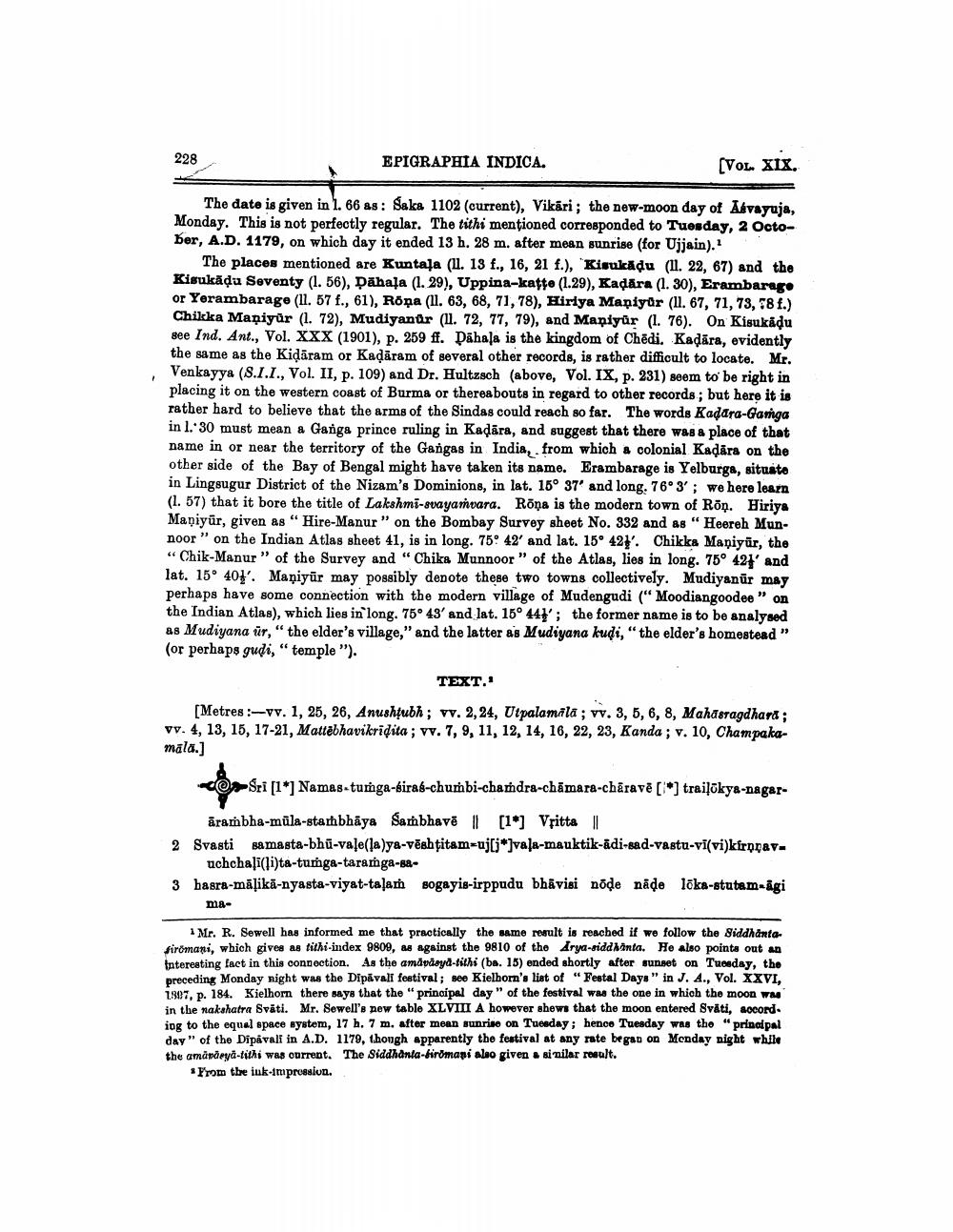________________
228
EPIGRAPHIA INDICA.
[VOL. XIX.
The date is given in 1. 66 as: Saka 1102 (current), Vikari; the new-moon day of Akvayuja, Monday. This is not perfectly regular. The tithi mentioned corresponded to Tuesday, 2 October, A.D. 1179, on which day it ended 13 h. 28 m. after mean sunrise (for Ujjain).
The places mentioned are Kuntala (11. 13 f., 16, 21 f.), "Kisukadu (11. 22, 67) and the Kisukāda Seventy (1. 56), Pahala (1. 29), Uppina-katto (1.29), Kadara (1.30), Erambarage or Yerambarage (11. 57 f., 61), Rona (11. 63, 68, 71, 78), Hiriya Mapiyür (11. 67, 71, 73, 8 f.) Chikka Maniyur (1. 72), Mudiyanur (1. 72, 77, 79), and Mapiyür (1. 76). On Kisukādu see Ind. Ant., Vol. XXX (1901), p. 259 ff. Pahala is the kingdom of Chēdi. Kadāra, evidently the same as the Kidāram or Kadāram of several other records, is rather difficult to locate. Mr. Venkayya (S.I.I., Vol. II, p. 109) and Dr. Hultzsch (above, Vol. IX, p. 231) seem to be right in placing it on the western coast of Burma or thereabouts in regard to other records; but here it is rather hard to believe that the arms of the Sindas could reach so far. The words Kadara-Garga in l. 30 must mean a Ganga prince ruling in Kadāra, and suggest that there was a place of that name in or near the territory of the Gangas in India, from which a colonial Kadāra on the other side of the Bay of Bengal might have taken its name. Erambarage is Yelburga, situato in Lingsugur District of the Nizam's Dominions, in lat. 16° 37' and long. 76°3'; we here learn (1. 57) that it bore the title of Lakshmi-svayamvara. Rõna is the modern town of Rõn. Hiriya Maniyūr, given as “Hire-Manur" on the Bombay Survey sheet No. 332 and as " Heereh Munnoor" on the Indian Atlas sheet 41, is in long. 75. 42' and lat. 15° 421. Chikka Maniyür, the “Chik-Manur" of the Survey and "Chika Munnoor" of the Atlas, lies in long. 75° 42' and lat. 15° 407. Maniyür may possibly denote these two towns collectively. Mudiyanür may perhaps have some connection with the modern village of Mudengudi ("Moodiangoodee" on the Indian Atlas), which lies in long. 75° 43' and lat. 15° 44%; the former name is to be analysed as Mudiyana ür," the elder's village," and the latter as Mudiyana kudi," the elder's homestead" (or perhaps gudi," temple ").
TEXT.
[Metres :-Vv. 1, 25, 26, Anushțubh ; v. 2, 24, Utpalamila; vv. 3, 5, 6, 8, Mahasragdhara; vv. 4, 13, 15, 17-21, Mattēbhavikridita; vv. 7, 9, 11, 12, 14, 16, 22, 23, Kanda ; v. 10, Champakamāla.]
Sri [l*) Namas-tunga-biras-chumbi-chandra-chämara-chāravě (*) traiļūkya-nagarārambha-mūla-stambhiya Sambhavë | [1*] Vritta | 2 Svasti samasta-bhū-vale(la)ya-vēshţitam=uj[j*]vala-mauktik-adi-sad-vastu-vi(vi)kirppav.
uchchali(li)ta-tumga-taramga-883 hasra-māļikā-nyasta-viyat-talam sogayis-irppudu bhävisi node näde lēka-stutam-agi
ma
* Mr. R. Sewell has informed me that practically the same result is reached if we follow the Siddhantasiromani, which gives as tithi-index 9809, as against the 9810 of the Arya-ridd Aanta. He also points out an Interesting fact in this connection. As the amapdayd-tithi (ba. 15) ended shortly after sunget on Tuesday, the preceding Monday night was the Dipávall festival; see Kielbom's list of "Festal Days" in J. A., Vol. XXVI. 1907, p. 184. Kielhom there says that the principal day of the festival was the one in which the moon w in the nakahatra Svati. Mr. Sewell's new tablo XLVIII A however shows that the moon entered Sväti, accord. ior to the equal space system, 17 h. 7 m. after mean sunrise on Tuesday: hence Tuesday was the principal day" of the Dipávall in A.D. 1179, though apparently the festival at any rate began on Monday night while the amanorya-tithi was ourrent. The Siddhanta-firmapi also given a similar result.
* From the iuk-Improssiun.




